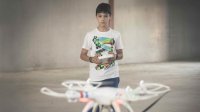Drones Can Be Fun—and Educational
Check out a variety of ways schools might use drones as a teaching tool.
Peering up, a teacher asked me, “What are we going to use it for?” as I flew our shiny new drone up between the umbrellas on the quad, past the roof of the gym, and into the low scattered clouds. The camera projected back to my iPhone, and I could see the newly planted trees in our quad, the only green for miles in the Mondrian concrete grid that is our local community.
The students and teachers in the quad all looked up too, shielding their eyes to see the drone fly. Our custodians pulled up in their cart, and my assistant principal whooped like one of the middle schoolers on my campus.
It’s my job this year to answer questions like the one above. As a teacher on special assignment currently serving as curriculum coordinator for my school, I get to learn what’s coming our way and devise methods of implementation. I specialize in technology and project-based learning, and I began thinking about implementing the drone immediately upon hearing that our district had purchased it.
And I’m not the only one thinking about this issue. In the book Drones in Education, the International Society for Technology in Education touts the engagement factor but also sees academic potential in using drones. To guide schools to successfully implement the technology, the book promotes the SOAR model, which stands for Safety (ethics and legal use), Operation (flight and maintenance), Active learning (engagement in problem solving), and Research (practical applications).
Using Drones in the Curriculum
In the spirit of SOAR, here are some suggestions for how to implement this technology.
1. Social Studies: Have students participate in kinesthetic cartography: Draw a map of the world in chalk and have the students “migrate” or conquer areas to show the spread of different empires. Photograph or record their movements to chronicle historical changes.
2. Language Arts: Illustrate different points of view. Take photos of little-seen areas of the school, and have students write guesses about where the photo might have been taken.
3. PE: Send the drone up during PE class to record students demonstrating a particular play. Have students watch the footage and discuss where they should have been and what they can do better.
4. Math: Create a gigantic graph. I spoke to Jim Bentley, a middle school teacher and a Buck Institute for Education national faculty member who has recently seen the value in using his new school drone to teach math. He told me, “Filmmaking is a key ingredient in our classroom. We recently obtained a drone to capture aerial footage for films we produce in conjunction with our city’s integrated waste department. But I realized that if we built a large four-quadrant graph on the playground with chalk, we could also use our drone to practice landing on different ordered pairs. With a drone, the sky’s the limit for what we could learn.”
5. Science: Look at the micro world and the macro world and the patterns repeated in each.
6. Community Building: Produce a video. We’ve seen lip-dubbed videos on YouTube. You no longer need to rent a crane (expensive) or borrow a wheelchair—as I once did—to use as a cheap, but bumpy, Steadicam. Drones allow you to see the school from above, and that can be very celebratory.
7. Current Events: Debate. What about privacy issues? What is the future of our workforce if companies like Amazon use drones for deliveries? Are drones a good technology, or are we one step closer to automaton domination?
8. Social and Emotional Learning: In terms of social and emotional learning, drones give students glimpses of themselves and their place in the world. This technology could help students visualize themselves as being a part of something greater while also helping them keep their me-me-me-ness in perspective. For tweens and teens at least, feeling a little “smaller” might help their decision-making in such a self-centric time of life.
The End of a Dream
I watched the drone hover about 60 feet off the ground, and it made me smile at the possibilities it represented. The people around me stood nodding, lost in the dreams I had shared.
And then it crashed.
The drone fell like a stone from the sky. The other teachers scattered, and the custodians’ cart left a trail of dust in its wake. Everyone abandoned me to the broken pieces of plastic hull and crushed curricular dreams.
I carried the corpse of the drone to my principal and wondered if this was a sign that it didn’t belong in schools. Or was it just an indication that I shouldn’t be the one to fly it?
